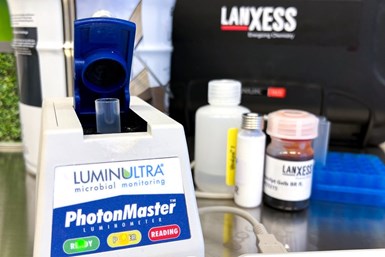Lanxess, Tennants Partner to Provide Integrated Solutions
The combination of ATP technology and biocide use intends to help save costs and improve operational hygiene.
Edited by

Photo Credit: Lanxess
Lanxess, a supplier of antimicrobial protection products, and Tennants GmbH are collaborating on integrated solutions in the field of industrial plant hygiene. The collaboration will see the partners combining Lanxess’ biocide portfolio and Tennants’ adenosine triphosphate (ATP) technology. ATP technology can be used to quickly and reliably detect a possible contamination with microorganisms. The collaboration will impact not only the paints and polymer manufacturing but also processing industries such as chemicals for inks, adhesives, plastics, textiles, leather, metalworking fluids, lubricants and building materials.
Inadequate industrial plant hygiene can lead to microbial disruptions or contamination of raw materials, production water and equipment as well as end products. Contaminated materials, which can lead to equipment failure and loss of productivity, are counter-productive. Therefore, proper industrial plant hygiene, preservation with appropriate biocide formulations and efficient, real-time and quantitative microbial control mechanisms, such as ATP technology, are essential for sustainable production.
“Plant hygiene is a key element of a proper preservation, especially in our ever tighter regulatory environment,” says Philipp Seidenstuecker, global marketing manager, Paints & Coatings at Lanxess. “The ATP technology from Tennants is an excellent way to monitor the hygiene level in the factory and to support a most efficient use of biocides. Customers of both companies benefit equally from this cooperation.”
ATP technology can reliably quantify microbial content in any sample, such as water, chemically complex samples and solids as well as on surfaces. It provides results within minutes. The test can be performed both in the laboratory and directly on-site at the plant. ATP technology can be used to determine the concentration of total biomass — including bacteria, yeasts and molds. The emphasis in using the tests is on prevention, not posttreatment.
“No microorganism goes undetected in quantitative analyses using second-generation ATP technology,” says Jasper Stegeman, general manager, ATP Technology at Tennants. “There are no false positive/false negative results compared to conventional methods.”
RELATED CONTENT
-
Regulatory Changes Drive Cleaning Companies' Collaboration
Hubbard-Hall and Jayco Cleaning Technologies have collaborated to develop a solution for new regulatory changes.
-
MicroCare Celebrates 40 Years of Critical Cleaning Solutions
The company was founded in October 1983.
-
Parts Cleaning Conference Announces 2022 Program Lineup
Co-located with IMTS, the Parts Cleaning Conference takes place Tuesday, September 13, 2022 at the McCormick Place in Chicago, IL.
















